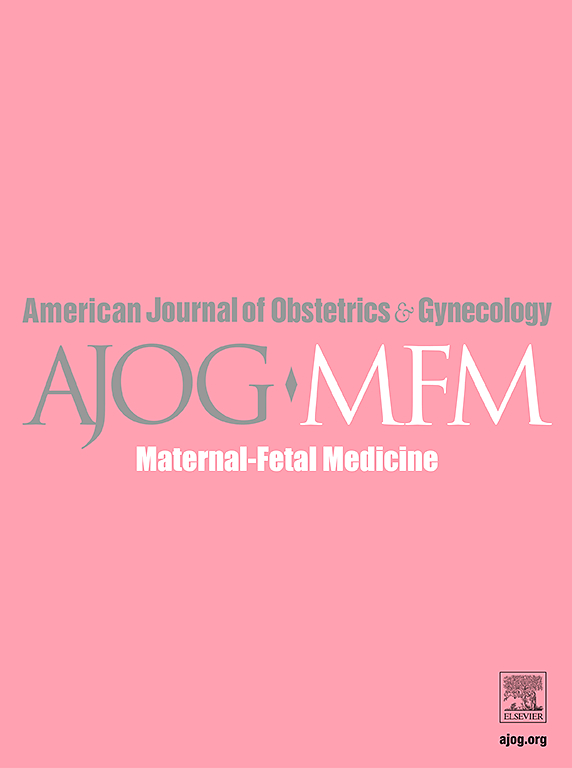Postpartum care in the neonatal intensive care unit, PeliCaN: a randomized controlled trial
IF 3.1
2区 医学
Q1 OBSTETRICS & GYNECOLOGY
American Journal of Obstetrics & Gynecology Mfm
Pub Date : 2025-05-06
DOI:10.1016/j.ajogmf.2025.101689
引用次数: 0
Abstract
BACKGROUND
Postpartum parents of hospitalized infants in neonatal intensive care units have higher rates of chronic disease and pregnancy complications than parents of well newborns. Neonatal intensive care unit parents may prioritize remaining at their infants’ bedsides over their healthcare.
OBJECTIVE
This study aimed to determine whether embedding doulas and certified nurse midwives for postpartum care in the neonatal intensive care unit (PeliCaN) would reduce the time to receive postpartum healthcare, with the hypothesis that the intervention would shorten the time and improve the comprehensiveness of postpartum care.
STUDY DESIGN
This was a parallel randomized controlled trial from November 29, 2022, to November 7, 2023, in a single-center, level 3 neonatal intensive care unit in a tertiary hospital in Philadelphia, Pennsylvania, with approximately 4200 births annually. Postpartum parents of infants who were born at <34 weeks of gestation, <2 weeks old, and anticipated to remain in the neonatal intensive care unit ≥1 week, were eligible. Of the 135 potentially eligible parents, the staff screened 78 for eligibility (constrained by access to just 4 hours per week of midwifery care), contacted 52 of 71 eligible parents, and enrolled 37 by 2 weeks after delivery. There were 20 parents randomized to the intervention group and 17 parents randomized to the control group via block randomization stratified by gestational age (<29 and ≥29 weeks) and insurance (public and private). The intervention consisted of postpartum doula support and midwifery clinical care in the neonatal intensive care unit for the duration of the infant’s hospitalization. Participants in the control group received usual care. The outcomes were measured at 12 weeks after delivery. All participants had complete follow-up data. The primary outcome was days to receive any postpartum care and to completion of 3 care components: blood pressure measurement and treatment if needed; depression screening and referral and treatment if indicated; and contraception counseling (if no sterilization procedure had been performed) and provision if patients desired. Planned secondary analyses included stratification by gestational age and insurance as well as assessing the rates of any postpartum care receipt.
RESULTS
Six participants (30.0%) in the intervention group and 6 participants (35.0%) in the control group were parents of infants born at <29 weeks of gestation, and 16 participants (80.0%) in the intervention group and 15 participants (88.2%) in the control group were publicly insured. The median times to the first postpartum visit were 11 days (interquartile range, 10–12) in the intervention group and 31 days (interquartile range, 26–37) in the control group (P<.001). In addition, 1 participant (5%) in the intervention group and 6 participants (35%) in the control group missed at least 1 of 3 care components, most commonly blood pressure measurements. Of note, 4 participants (23%) in the control group did not have a blood pressure measurement, one of whom had preeclampsia. There were no differences in outcomes by infant gestational age or insurance.
CONCLUSION
In this single-center randomized controlled trial, the postpartum care in the neonatal intensive care unit model of on-site doula and midwifery care, PeliCaN, expedited and enhanced postpartum care. Multicenter trials and implementation science work are urgently needed to establish broader utility and feasibility.
新生儿重症监护病房(PeliCaN)的产后护理-一项随机对照试验。
背景:新生儿重症监护病房(NICUs)住院婴儿的产后父母比正常新生儿的父母有更高的慢性疾病和妊娠并发症发生率。新生儿重症监护室的父母可能会优先考虑留在婴儿床边,而不是自己的医疗保健。目的:探讨在新生儿重症监护室(PeliCaN)嵌入助产师和持证助产士的产后护理是否会缩短产后护理的接收时间。我们假设干预可以缩短时间,提高产后护理的综合性。研究设计:我们于2022年11月29日至2023年11月7日在宾夕法尼亚州费城一家三级医院的单中心III级NICU进行了一项平行随机对照试验(RCT),每年约有4200名新生儿。结果:6名(30%)干预参与者和6名(35%)对照参与者是婴儿的父母。结论:在本单中心随机对照试验中,PeliCaN模式对新生儿重症监护病房父母的现场助产师和助产护理加快并加强了产后护理。迫切需要多中心试验和实施科学工作,以建立更广泛的实用性和可行性。
本文章由计算机程序翻译,如有差异,请以英文原文为准。
求助全文
约1分钟内获得全文
求助全文
来源期刊

American Journal of Obstetrics & Gynecology Mfm
Medicine-Medicine (all)
CiteScore
7.40
自引率
3.20%
发文量
254
审稿时长
40 days
期刊介绍:
The American Journal of Obstetrics and Gynecology (AJOG) is a highly esteemed publication with two companion titles. One of these is the American Journal of Obstetrics and Gynecology Maternal-Fetal Medicine (AJOG MFM), which is dedicated to the latest research in the field of maternal-fetal medicine, specifically concerning high-risk pregnancies. The journal encompasses a wide range of topics, including:
Maternal Complications: It addresses significant studies that have the potential to change clinical practice regarding complications faced by pregnant women.
Fetal Complications: The journal covers prenatal diagnosis, ultrasound, and genetic issues related to the fetus, providing insights into the management and care of fetal health.
Prenatal Care: It discusses the best practices in prenatal care to ensure the health and well-being of both the mother and the unborn child.
Intrapartum Care: It provides guidance on the care provided during the childbirth process, which is critical for the safety of both mother and baby.
Postpartum Issues: The journal also tackles issues that arise after childbirth, focusing on the postpartum period and its implications for maternal health. AJOG MFM serves as a reliable forum for peer-reviewed research, with a preference for randomized trials and meta-analyses. The goal is to equip researchers and clinicians with the most current information and evidence-based strategies to effectively manage high-risk pregnancies and to provide the best possible care for mothers and their unborn children.
 求助内容:
求助内容: 应助结果提醒方式:
应助结果提醒方式:


